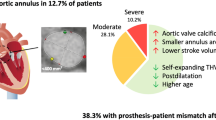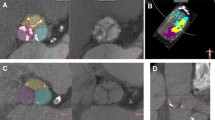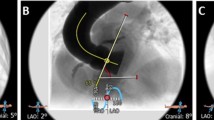Abstract
Background
Some patients referred for transcatheter aortic valve replacement (TAVR) have excessively large annuli (ELA) without device options according to current sizing charts. This retrospective study aims to summarize the presentation and outcomes of ELA patients receiving first-generation self-expanding valves.
Methods
The TAVR database was reviewed in search for cases of self-expanding valves. Patients who had annuli exceeding the perimeter limit on the device sizing chart were referred to as the ELA group. Patients who had annuli within the range covered by the two largest sizes and received the corresponding valve size served as the control group (CG). Baseline, procedures, outcomes, and imaging characteristics on multislice computed tomography (MSCT), such as native anatomy and postimplant stent geometry, were compared.
Results
A total of 28 patients were included in the ELA group and 82 in the CG. The patients in the ELA group were younger than those in the CG (72.5 ± 6.2 vs. 75.4 ± 5.8 years, P = 0.03). The median intended perimeter oversizing in relation to the annulus in the ELA group was much smaller than in the CG (−0.4 [−4.6, 4.1] % vs. 16.1 [11.7, 20.8] %, P < 0.01). The calcium burden in the aortic root was around 1.3-fold greater in the ELA group than the CG (756.0 [534.5, 1670.9] vs. 582.1 [310.3, 870.9] mm3, P = 0.01). The need for second valve implantation was higher in ELA (21.4% vs. 12.2%, P = 0.23) but no valve embolization was encountered. The 1‑year follow-up was comparable, including >mild paravalvular leak.
Conclusion
Under cautious patient selection using MSCT, TAVR with self-expanding valves in patients with ELA appears feasible. Supra-annular structures likely provide the extra anchoring.
Zusammenfassung
Hintergrund
Einige Patienten, die einen transkathetergestützten Aortenklappenersatz (TAVR) erhielten, haben gemäß den aktuellen Größentabellen extrem große Anuli (ELA) ohne Geräteoptionen. Diese retrospektive Studie soll die Präsentation und die Ergebnisse von ELA-Patienten zusammenfassen, die selbstexpandierende Herzklappen der ersten Generation erhalten haben.
Methoden
Für die Suche nach Fällen von selbstexpandierenden Herzklappen wurde die TAVR-Datenbank überprüft. Patienten, bei denen die Anuli die Perimetergrenze auf der Größentabelle des Geräts überschritten, wurden der ELA-Gruppe zugeteilt. Patienten, deren Anuli innerhalb des von den beiden größten Größen abgedeckten Bereichs lagen und welche die entsprechende Klappengröße erhielten, wurden der Kontrollgruppe (CG) zugewiesen. Baseline, Verfahren, Ergebnisse und Bildgebungscharakteristika der Mehrschicht-Computertomographie (MSCT), wie die native Anatomie und die Geometrie nach Implantation des Stents, wurden verglichen.
Ergebnisse
Insgesamt wurden 28 Patienten in die ELA-Gruppe und 82 in die CG aufgenommen. Die Patienten in der ELA-Gruppe waren jünger als die in der CG (72,5 ± 6,2 vs. 75,4 ± 5,8 Jahre; p = 0,03). Die mittlere beabsichtigte Überdimensionierung des Perimeters im Verhältnis zum Anulus war in der ELA-Gruppe deutlich kleiner als in der CG (−0,4 [−4,6–4,1] % vs. 16,1 [11,7–20,8] %; p < 0,01). Die Kalziumbelastung in der Aortenwurzel war in der ELA-Gruppe etwa 1,3-mal höher als in der CG (756,0 [534,5–1670,9] vs. 582,1 [310,3–870,9] mm3; p = 0,01). Die Notwendigkeit einer zweiten Klappenimplantation war in der ELA-Gruppe höher (21,4% vs. 12,2%; p = 0,23), aber es wurde keine Klappenembolisation festgestellt. Das 1‑Jahres-Follow-up war vergleichbar, einschließlich eines >milden paravalvulären Lecks.
Schlussfolgerung
Bei vorsichtiger Patientenauswahl mittels MSCT erscheint eine TAVR mit selbstexpandierenden Klappen bei Patienten mit ELA machbar. Die supraanulären Strukturen bieten wahrscheinlich die zusätzliche Verankerung.


Similar content being viewed by others
References
Willson AB, Webb JG, Labounty TM et al (2012) 3‑dimensional aortic annular assessment by multidetector computed tomography predicts moderate or severe paravalvular regurgitation after transcatheter aortic valve replacement: a multicenter retrospective analysis. J Am Coll Cardiol 59:1287–1294. https://doi.org/10.1016/j.jacc.2011.12.015
Barr P, Ormiston J, Stewart J et al (2018) Transcatheter aortic valve implantation in patients with a large aortic annulus. Heart Lung Circ 27:e11–e14. https://doi.org/10.1016/j.hlc.2017.08.025
Miyasaka M, Yoon S‑H, Sharma RP et al (2019) Clinical outcomes of transcatheter aortic valve implantation in patients with extremely large annulus and SAPIEN 3 dimensions based on post-procedural computed Tomography. Circ J 83:672–680. https://doi.org/10.1253/circj.CJ-18-1059
Xiong T‑Y, Li Y‑J, Feng Y et al (2019) Understanding the interaction between transcatheter aortic valve prostheses and supra-annular structures from post-implant stent geometry. JACC Cardiovasc Interv 12:1164–1171. https://doi.org/10.1016/j.jcin.2019.02.051
Jilaihawi H, Wu Y, Yang Y et al (2015) Morphological characteristics of severe aortic stenosis in China: imaging corelab observations from the first Chinese transcatheter aortic valve trial. Catheter Cardiovasc Interv 85(Suppl 1):752–761. https://doi.org/10.1002/ccd.25863
Zhou D, Pan W, Wang J et al (2020) VitaflowTM transcatheter valve system in the treatment of severe aortic stenosis: one-year results of a multicenter study. Catheter Cardiovasc Interv 95:332–338. https://doi.org/10.1002/ccd.28226
Xiong T‑Y, Feng Y, Li Y‑J et al (2018) Supra-annular sizing for transcatheter aortic valve replacement candidates with bicuspid aortic valve. JACC Cardiovasc Interv 11:1789–1790. https://doi.org/10.1016/j.jcin.2018.06.002
Guo Y, Yang Z, Shao H et al (2013) Right ventricular dysfunction and dilatation in patients with mitral regurgitation: analysis using ECG-gated multidetector row computed tomography. Int J Cardiol 167:1585–1590. https://doi.org/10.1016/j.ijcard.2012.04.104
Mylotte D, Lefevre T, Sondergaard L et al (2014) Transcatheter aortic valve replacement in bicuspid aortic valve disease. J Am Coll Cardiol 64:2330–2339. https://doi.org/10.1016/j.jacc.2014.09.039
Schultz CJ, Weustink A, Piazza N et al (2009) Geometry and degree of apposition of the CoreValve ReValving system with multislice computed tomography after implantation in patients with aortic stenosis. J Am Coll Cardiol 54:911–918. https://doi.org/10.1016/j.jacc.2009.04.075
Blanke P, Willson AB, Webb JG et al (2014) Oversizing in transcatheter aortic valve replacement, a commonly used term but a poorly understood one: dependency on definition and geometrical measurements. J Cardiovasc Comput Tomogr 8:67–76. https://doi.org/10.1016/j.jcct.2013.12.020
Kazuno Y, Maeno Y, Kawamori H et al (2016) Comparison of SAPIEN 3 and SAPIEN XT transcatheter heart valve stent-frame expansion: evaluation using multi-slice computed tomography. Eur Heart J Cardiovasc Imaging 17:1054–1062. https://doi.org/10.1093/ehjci/jew032
Grube E, Schuler G, Buellesfeld L et al (2007) Percutaneous aortic valve replacement for severe aortic stenosis in high-risk patients using the second- and current third-generation self-expanding CoreValve prosthesis: device success and 30-day clinical outcome. J Am Coll Cardiol 50:69–76. https://doi.org/10.1016/j.jacc.2007.04.047
Xu Y‑N, Xiong T‑Y, Li Y‑J et al (2020) Balloon sizing during transcatheter aortic valve implantation : comparison of different valve morphologies. Herz 45:192–198. https://doi.org/10.1007/s00059-018-4714-2
Kappetein AP, Head SJ, Genereux P et al (2012) Updated standardized endpoint definitions for transcatheter aortic valve implantation: the Valve Academic Research Consortium‑2 consensus document. Eur Heart J 33:2403–2418. https://doi.org/10.1093/eurheartj/ehs255
Leon MB, Smith CR, Mack MJ et al (2016) Transcatheter or surgical aortic-valve replacement in intermediate-risk patients. N Engl J Med 374:1609–1620. https://doi.org/10.1056/NEJMoa1514616
Kuhn C, Frerker C, Meyer A‑K et al (2018) Transcatheter aortic valve implantation with the 34 mm self-expanding CoreValve Evolut R: initial experience in 101 patients from a multicentre registry. EuroIntervention 14:e301–e305. https://doi.org/10.4244/EIJ-D-17-01153
Sathananthan J, Sellers S, Barlow A et al (2018) Overexpansion of the SAPIEN 3 transcatheter heart valve: an ex vivo bench study. JACC Cardiovasc Interv 11:1696–1705. https://doi.org/10.1016/j.jcin.2018.06.027
Hopf R, Sündermann SH, Born S et al (2017) Postoperative analysis of the mechanical interaction between stent and host tissue in patients after transcatheter aortic valve implantation. J Biomech 53:15–21. https://doi.org/10.1016/j.jbiomech.2016.12.038
Wang Q, Sirois E, Sun W (2012) Patient-specific modeling of biomechanical interaction in transcatheter aortic valve deployment. J Biomech 45:1965–1971. https://doi.org/10.1016/j.jbiomech.2012.05.008
Liu X, He Y, Zhu Q et al (2018) Supra-annular structure assessment for self-expanding transcatheter heart valve size selection in patients with bicuspid aortic valve. Catheter Cardiovasc Interv 91:986–994. https://doi.org/10.1002/ccd.27467
Tchetche D, de Biase C, van Gils L et al (2019) Bicuspid aortic valve anatomy and relationship with devices: The BAVARD multicenter registry: A European picture of contemporary multidetector computed tomography sizing for bicuspid valves. Circ Cardiovasc Interv. https://doi.org/10.1161/CIRCINTERVENTIONS.118.007107
Jilaihawi H, Chin D, Spyt T et al (2011) Comparison of complete versus incomplete stent frame expansion after transcatheter aortic valve implantation with Medtronic CoreValve bioprosthesis. Am J Cardiol 107:1830–1837. https://doi.org/10.1016/j.amjcard.2011.02.317
Kochman J, Rymuza B, Huczek Z (2015) Transcatheter aortic valve replacement in bicuspid aortic valve disease. Curr Opin Cardiol 30:594–602. https://doi.org/10.1097/HCO.0000000000000219
Popma JJ, Gleason TG, Yakubov SJ et al (2016) Relationship of annular sizing using multidetector computed tomographic imaging and clinical outcomes after self-expanding corevalve transcatheter aortic valve replacement. Circ Cardiovasc Interv. https://doi.org/10.1161/CIRCINTERVENTIONS.115.003282
Funding
This work was supported by the National Natural Science Foundation of China (81970325); the 1.3.5 project for disciplines of excellence, West China Hospital, Sichuan University; and Science and Technology Support Plan of Sichuan Province (2017JY0330 and 2018SZ0172).
Author information
Authors and Affiliations
Contributions
MC and YF conceived and designed research. YJL, YO, ZJW, XW, XL, and YF collected raw data and performed follow-ups. YBL and FC analyzed data. TYX and YLB wrote the manuscript. WM and ZGZ made critical revision suggestions to the manuscript. All authors read and approved the manuscript.
Corresponding author
Ethics declarations
Conflict of interest
T.-Y. Xiong, Y.-B. Liao, Y.-J. Li, F. Chen, Y. Ou, X. Wang, Z.-J. Wang, X. Li, Z.-G. Zhao and W. Meng declare that they have no competing interests. Y. Feng and M. Chen are consultants/proctors of Venus MedTech and MicroPort.
The study was approved by the Research Ethics Board of West China Hospital. Written informed consent was obtained from all study participants.
Additional information
Availability of data and material
The data are available from the corresponding author on reasonable request.
Caption Electronic Supplementary Material
Rights and permissions
About this article
Cite this article
Xiong, TY., Liao, YB., Li, YJ. et al. Treating patients with excessively large annuli with self-expanding transcatheter aortic valves: insights into supra-annular structures that anchor the prosthesis. Herz 46 (Suppl 2), 166–172 (2021). https://doi.org/10.1007/s00059-020-04973-5
Received:
Revised:
Accepted:
Published:
Issue Date:
DOI: https://doi.org/10.1007/s00059-020-04973-5
Keywords
- Aortic stenosis
- Transcatheter aortic valve replacement
- Self-expanding valves
- Challenging anatomy
- Treatment outcome




